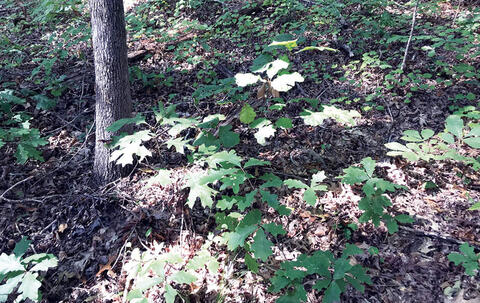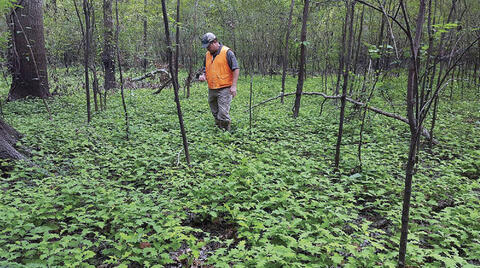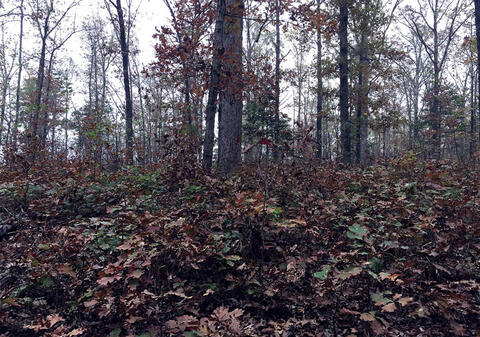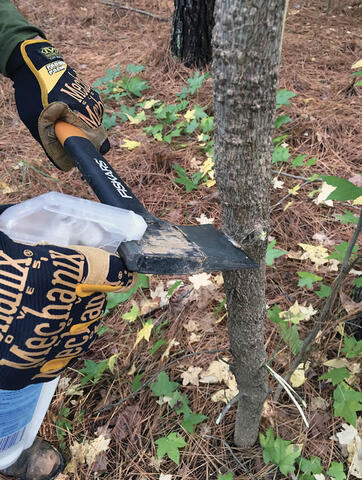P3476
Upland Hardwoods: Natural Regeneration

Regeneration of upland hardwood stands can be a problematic. Often, no provision is made for the future of a stand before harvesting, and many landowners forgo the use of artificial regeneration due to high establishment costs that must be carried over long rotations. As a system, natural regeneration can be effective for regenerating upland-hardwood stands. It provides an affordable means of reestablishing a stand using existing trees as a seed source. Obviously, enough desirable trees have to be present in the current stand for the process to succeed, but when it is properly conducted, a young stand dominated by desirable species such as oaks will naturally regenerate with good results.
Focusing on Oak Regeneration
Multiple nonoak species have various commercial, aesthetic, wildlife, and other values. Species including sweetgum, ashes, maples, elms, and others may be helpful in achieving some management goals, but they often have serious negative competitive effects on developing oak seedlings. Oaks are very important commercially for production of wood products such as flooring, furniture, and lumber. In addition, oaks provide shelter and food for many species of wildlife. Oaks also provide aesthetic and environmental benefits. When these factors are combined, oak species are often viewed as the most valuable species group for many management objectives. Consequently, oaks are typically the focus of most upland hardwood management practices.
Natural Regeneration
Natural regeneration is simply the process of regenerating a forest using reproduction produced by trees already in the stand. Three types of seedlings make up natural regeneration: (1) new seedlings, (2) advanced regeneration, and (3) stump sprouts.
New Seedlings
New seedlings are recently germinated seedlings, usually only a few inches tall. After good mast crop years, large numbers of these seedlings can be observed in many hardwood stands. However, they have small root systems with very little energy reserves needed for successful competition. They also are too small to compete successfully for light when forced into competition with other vegetation after harvesting. Very few seedlings become established after harvest; most die during the first growing season after germination. Consequently, managers cannot rely on this type of regeneration for satisfactory reestablishment of a stand.

Advanced Regeneration
Advanced regeneration is defined as well-established seedlings with good root systems existing before harvest. These seedlings should be between 1 and 4 feet in height and possess root-collar diameters of at least ¼ inch. Due to established root systems, these seedlings are in a much better position to compete for growing space in the newly regenerated stand. Advanced regeneration is the most important element in success of natural regeneration in upland hardwoods.

Stump Sprouts
Stump sprouts are stems that sprout from stumps of severed trees. They are rarely sufficient in number or quality to drive successful regeneration of a stand by themselves. However, they can be important in situations where low quantities of advanced regeneration exist before harvesting.

Challenges Encountered When Practicing Natural Regeneration
Often, the most difficult challenge to overcome when using natural regeneration on upland sites is that of establishing oak seedlings in regenerated stands. Obtaining advanced oak regeneration is an absolute necessity if the objective is to maintain the presence of oaks in the next stand. Several factors determine the minimum amount of oak advanced regeneration needed to properly regenerate the stand after harvest. These include site quality, species composition, seedling size, and the sprouting potential of stumps.
Determining the amount of oak advanced regeneration required for successful regeneration of a stand requires substantial knowledge and experience in hardwood management. There are evaluative tools available to help with determination of this number; however, they are complex and may be difficult for an inexperienced hardwood manager. In addition, these evaluation tools are usually designed for use in a geographically designated region and should not be utilized outside of that area. Thus, it is important that landowners consult foresters well versed in hardwood management when attempting to evaluate potential of upland hardwood sites.
Site Quality
Site quality can also be thought of as soil productivity because soil properties influence the ability of a site to grow different tree species. Consideration of site quality tells managers which species will perform best on a given site. In more mountainous regions of the nation, slope aspect warrants consideration when evaluating a stand. Due to the relatively flat terrain found across most of Mississippi, aspect is rarely a driver of site quality in upland hardwood stands. In the regeneration phase of forest management, perhaps the most substantial role that site quality plays is its effect on the degree of competition that can be expected. Higher quality sites are more productive for desirable oak regeneration and increased competition, as well. Consequently, higher quality sites typically require larger numbers of advanced oak regeneration for success in natural regeneration efforts compared to low-quality sites.
Species Composition
Species composition also plays an important role in determining the amount of advanced regeneration needed for natural regeneration on upland hardwood sites. If a stand possesses substantial numbers of fast-growing, shade-intolerant species like sweetgum, greater numbers of advanced oak regeneration are likely required to ensure survival of adequate oaks in the newly regenerated stand. Many upland hardwood stands have a substantial component of shade-tolerant species like elms and maples. These species can create significant competition problems for oak regeneration. In cases where competing stems exist in problematic quantities, some form of chemical competition control (injection or directed-spray applications of herbicides) may be necessary for reduction of undesirable tree numbers within a stand.
Seedling Size
Seedling size is extremely important in determining adequacy of advanced regeneration. Advance regeneration should be between 1 and 4 feet tall, compared to the 1 to 4 inches of height typically observed in new seedlings. If the majority of regeneration is less than 1 foot in height, many more seedlings will need to be present.
Stump Sprouts
Stump sprouts can serve in a compensatory role in natural regeneration. While they typically are not relied upon as a sole source of regeneration, they can be important in situations where advanced regeneration is lacking. The sprouting potential of a tree is dependent on its size, age, and species. Smaller trees (2 to 10 inches in diameter at ground level) that are less than 40 years old typically are prolific stump sprouters.
Harvesting Methods for Natural Regeneration
Silvicultural management of forests can be classified as either even aged or uneven aged. Even-aged management is defined as managing a stand where all trees are within a few years of the same age (age range of trees is within 20 percent of the rotation length). Due to shade intolerance of most desirable hardwood species in the South (pine, oak, ash, etc.) even-aged management is the regeneration system used in most efforts.
Uneven-aged management involves maintaining trees of at least three different age classes in the same stand. Shading from overstory trees that comprise older age classes makes regeneration of shade-intolerant species very problematic. Recruiting oak advance regeneration into the overstory is difficult, and a high percentage of resulting trees often will be of undesirable shade-tolerant species.
Even-Aged Methods
There are several types of harvests that result in even-aged stands. Two of these harvesting types are commonly used in the South, clear-cutting and shelterwood harvesting. Clear-cutting involves the simultaneous removal of all trees and may be the only way to harvest some stands. If applied properly, it can be an excellent method for regenerating desirable hardwoods. However, if there is not an adequate number of oak advance regeneration at the time of harvesting and all overstory canopy trees are not removed, oak reestablishment is unlikely. Often clear-cutting operations focus only on maximizing profit and leave substantial numbers of small-diameter trees of undesirable species that make development of desirable species like oaks difficult.
Shelterwood harvesting involves a series of cuts designed to leave mature trees of desirable species to produce and protect regeneration. The first step in a shelterwood operation is the removal of small-diameter stems of undesirable species in order to reduce competition and promote desirable regeneration. In stands with large numbers of these nonmerchantable trees, the process is usually accomplished using stem injection or hack-n-squirt with herbicides. For more specific information on these applications, please read Mississippi State University Extension Publication 2942, Tree Injection for Timber Stand Improvement. For best results, injection should take place in the year preceding the first overstory removal step in the shelterwood.
The next step in a shelterwood harvest is removal of a significant portion of overstory trees. Typically, 50 to 60 percent of canopy trees are removed to produce optimal light conditions for desirable oak regeneration. An acceptable range of light conditions is between 40 and 60 percent, with 50 percent available light being optimal for supporting oak regeneration. This partial harvest is designed to remove a large enough portion of the canopy to increase ground-level light availability while leaving a sufficient number of trees to provide some shade for competition reduction and seed. After desirable regeneration has been established (usually between 2 and 5 years), the remaining trees should be harvested. Some owners want to maintain these trees for aesthetic purposes. However, residual trees will impede development of oak regeneration.

Uneven-Aged Methods
Uneven-aged management includes single-tree selection and group selection methods. Single-tree selection involves the removal of individual trees scattered throughout the stand for the purpose of establishing regeneration in the resulting openings. The problem with this method is the shade-intolerant nature of most desirable species in the South. Single-tree selection results in very little increase in ground-level light in small, individual tree openings. As a result, it favors undesirable shade-tolerant species.
Group selection involves removing groups of trees to create small openings for the establishment of regeneration. Typically, recommendations suggest group selections of 1 to 2 acres; however, some research indicates that group selections should encompass 5 to 7 acres to ensure adequate maintenance of regeneration inside openings. These areas regenerate like clear-cut harvests and are often viewed as small even-aged stands from an actual methodological approach. The method can create environmental conditions that promote desirable species like oaks, but the same criteria as clear-cut harvesting must be met.
Selecting a Regeneration Method
Selecting a regeneration method should be based on the amount of advanced regeneration already present in a stand when the decision is made to proceed with reestablishment. The goal of regeneration is not to establish a stand of pure oak but one with a significant component of oak (at least 40 percent). Determining the amount of oak advanced regeneration present is a simple process. Regeneration evaluation in hardwood stands is performed using 100th-acre (11.8-foot radius) circular plots. Seedlings should be tallied in the sample area by size class (less than 1 foot, 1 to 3 feet, and greater than 3 feet in height) and converted to per-acre values after collecting data from several plots. One regeneration plot should be taken for every 2 acres in smaller stands (up to 40 or 50 acres). Assuming adequate distribution of regeneration sampling, the ratio of plots per acre can increase in larger stands, but regeneration data should still be recorded on at least 25 to 30 plots spread across the stand. This data can then be used to determine if a stand is sufficiently stocked to a level that oak can be expected in the newly established stand.
If oak advanced regeneration is in sufficient quantity, clear-cutting may be an appropriate method on some upland hardwood sites. If clear-cutting is not preferred, group selection could be utilized in areas with higher numbers of advanced regeneration. However, once overstory trees are removed, there will not be a seed source for future regeneration attempts. If the regenerated stand fails, artificial regeneration will be the only recourse for reestablishing an oak stand.
In stands that do not contain an adequate supply of advanced regeneration, a regeneration method that encourages continued development of seedlings should be used. In these stands, the shelterwood method will provide the best results. The time period from start to finish varies, and the status of existing regeneration will influence how long it takes to complete the process. This period often ranges from 2 to 5 years—in some cases, longer than 10 years—to establish oak advanced regeneration large enough to compete when the residual overstory is removed.
Conclusion
Natural regeneration is an efficient and economical tool for regeneration of upland hardwood stands. Careful planning and implementation are required when performing harvests to promote natural regeneration. Hardwoods will regenerate naturally without planning, but there is little control of the condition of these stands and the likelihood of maintaining desirable species is decreased. Consequently, if your personal experience in hardwood management is limited, seek the services of a professional forester before conducting natural regeneration activities in upland hardwoods.
Suggested Reading
Cunningham, K., and T. Walkingstick. 2012. Using Natural Regeneration to Promote Oaks in Upland Hardwood Stands, University of Arkansas Cooperative Extension Service, Fact Sheet 5010. 4p.
Self, A. B. 2019. Tree Injection for Timber Stand Improvement. MSU-E Publication 2942. 8p.
Publication 3476 (POD-06-23)
By A. Brady Self, PhD, Associate Extension Professor, Forestry, and Kyle Cunningham, PhD, Assistant Professor, University of Arkansas Cooperative Extension Service. Adapted for Mississippi from Using Natural Regeneration to Promote Oaks in Upland Hardwood Stands, University of Arkansas Cooperative Extension Service Fact Sheet 5010.
The Mississippi State University Extension Service is working to ensure all web content is accessible to all users. If you need assistance accessing any of our content, please email the webteam or call 662-325-2262.
